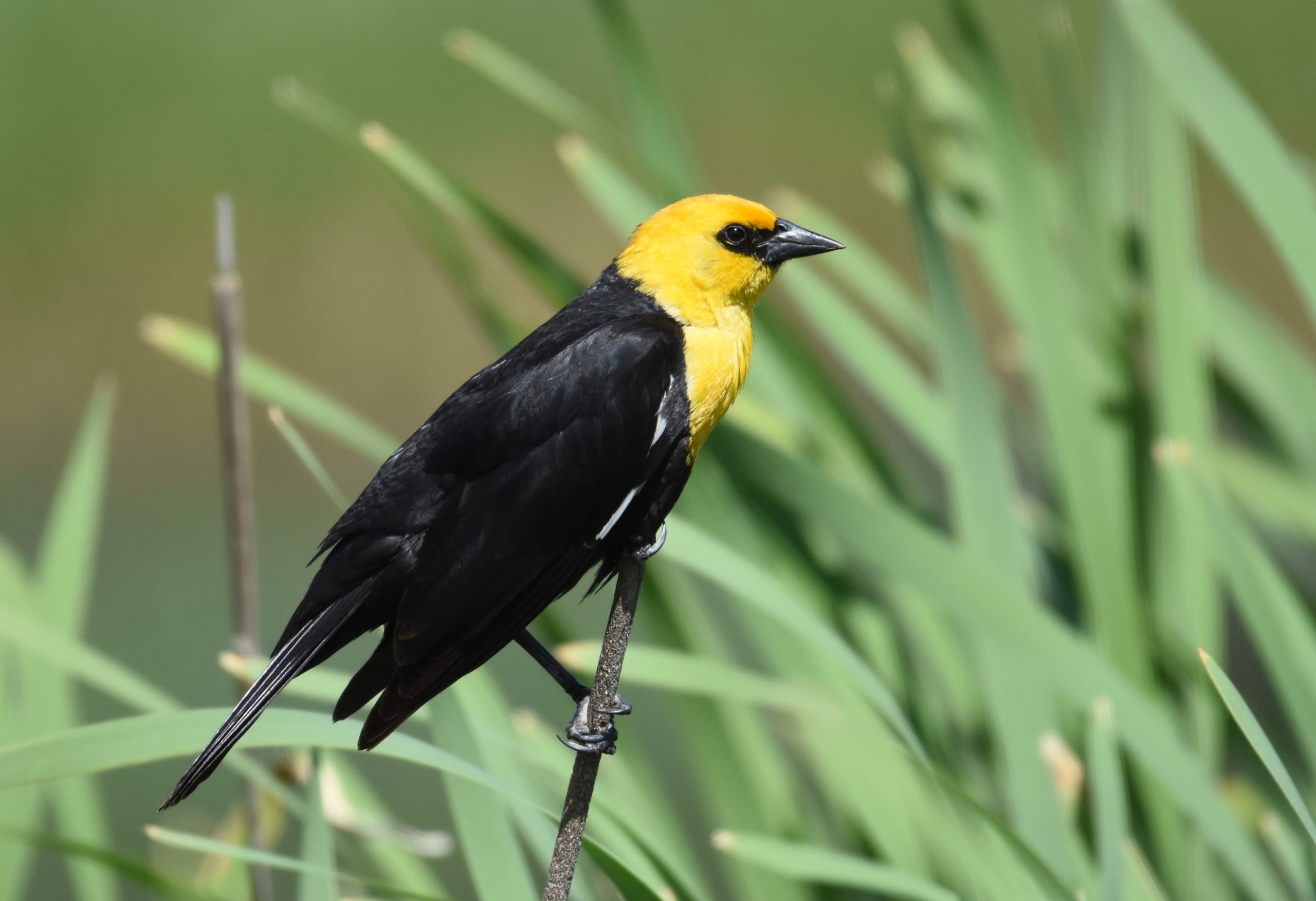In the spring and summer months when warblers migrate to North Dakota, it is common to see yellow birds, but during winter, only a few species of yellow birds remain.
This comprehensive guide will assist you in identifying the yellow birds you spot in North Dakota. It provides pictures, identification details, song recordings, and migration patterns.
The majority of yellow birds in North Dakota are warblers, orioles, or tanagers. It is worth noting that sometimes female birds of these species look vastly different from their male counterparts.
With the wealth of information presented in this guide, identifying yellow birds will become much simpler. The list is organized based on the frequency of sightings in North Dakota during the spring and summer months (May and June), according to ebird checklists.
Yellow birds in North Dakota during the summer include the American Goldfinch, Western Meadowlark, Yellow Warbler, Cedar Waxwing, Yellow-headed Blackbird, Common Yellowthroat, Western Kingbird, Baltimore Oriole, American Redstart, Orchard Oriole, Yellow-throated Vireo, Dickcissel, and Scarlet Tanager.
During the winter, the Evening Grosbeak is the only yellow bird typically found in North Dakota.
When it comes to migration, you can expect to see Yellow-rumped Warblers, Orange-crowned Warblers, Palm Warblers, Magnolia Warblers, Wilson’s Warblers, Nashville Warblers, Canada Warblers, Cape May Warblers, and Black-throated Green Warblers passing through North Dakota.
Continue reading this guide to identify the yellow birds you have encountered in your observations.
Here are 23 Yellow Birds in North Dakota:
1. American Goldfinch
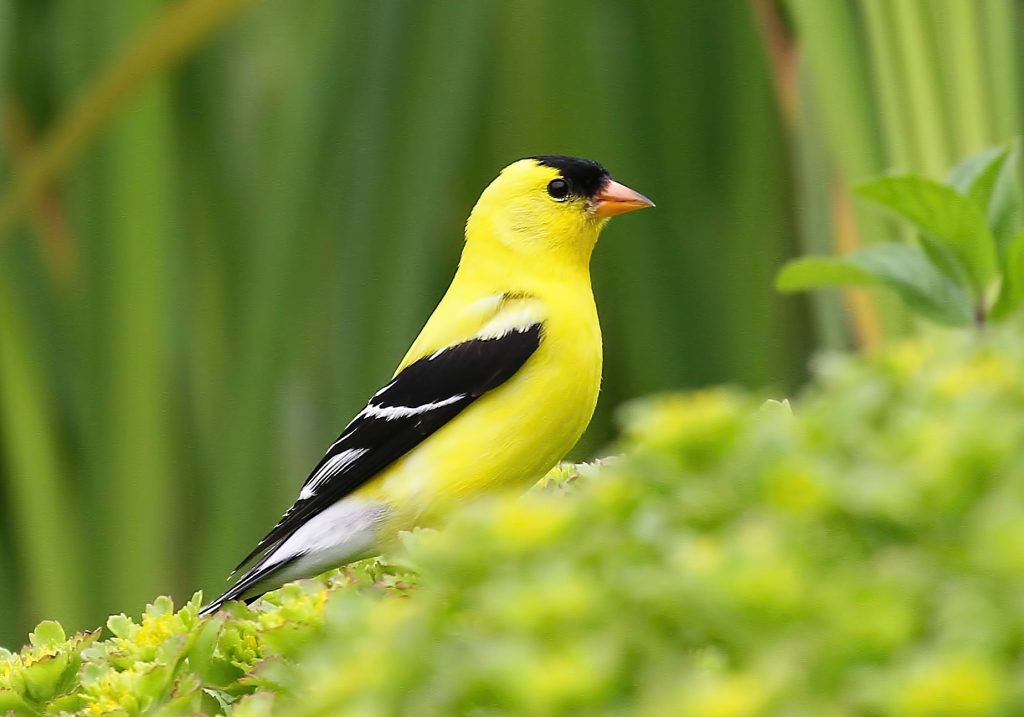
The American Goldfinch is a delightful bird with vibrant yellow and black plumage during the breeding season. In North Dakota, they can be seen from May to September in the northern parts, and they are present throughout the state year-round, appearing in 34% of summer checklists and 8% of winter checklists.
American Goldfinches are cherished for their beauty. The males boast bright yellow and black feathers in spring, while the females and males in winter exhibit more subdued brown tones.
Spinus tristis
Length: 4.3-5.1 in (11-13 cm)
Weight: 0.4-0.7 oz (11-20 g)
Wingspan: 7.5-8.7 in (19-22 cm)
American Goldfinches can be found across most of North America, residing there throughout the year. However, those that breed in Canada and the Midwest migrate to the southern United States during the winter.
These birds can be spotted in weedy fields, overgrown areas, suburbs, parks, and backyards, where they forage for sunflower, thistle, and aster plants.
Enjoy the melodious song of the American Goldfinch:
American Goldfinch nests are typically built in saplings or shrubs using grass, bark strips, and feathers. The female lays four to six eggs, which hatch in ten to twelve days. While the male feeds the female, she incubates the eggs.
Attract American Goldfinches to your backyard by planting thistles and milkweed. They are frequent visitors to bird feeders and have a preference for sunflower seeds and nyjer seed.
Fun Fact: Brown-headed Cowbirds sometimes lay eggs in American Goldfinch nests. Unfortunately, the seed-based diet provided by the Goldfinch parents is unsuitable for the Cowbird chicks, leading to their demise.
2. Western Meadowlark
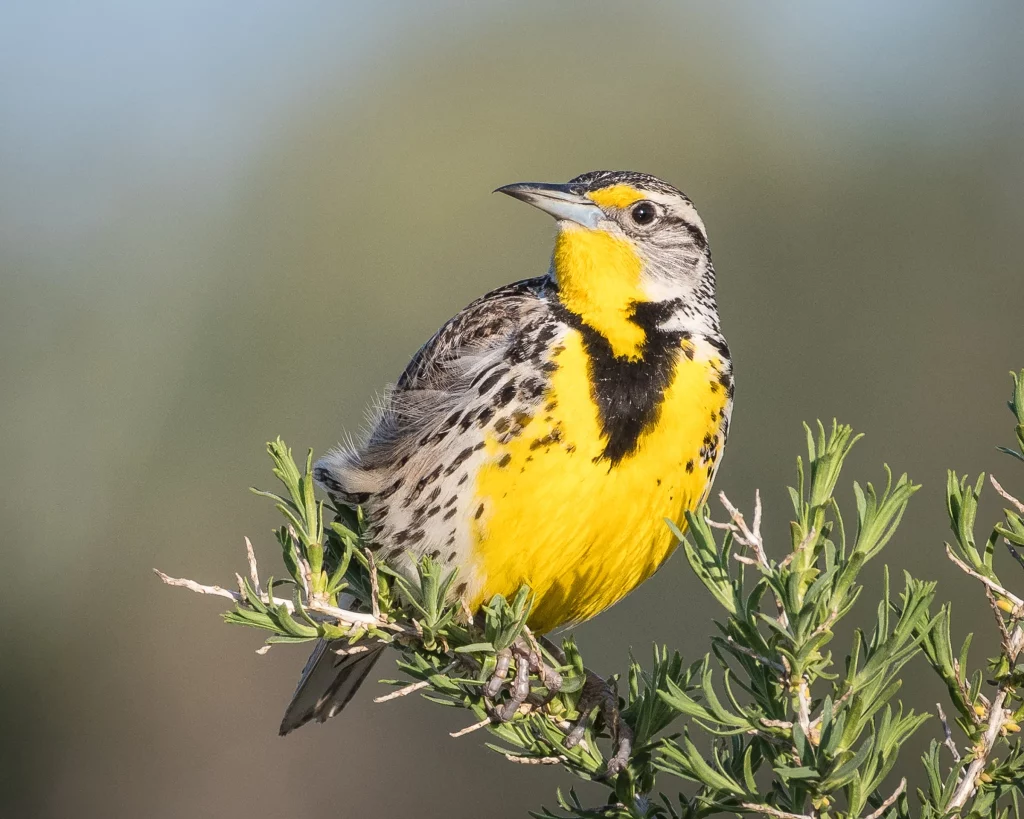
The Western Meadowlark is a commonly observed yellow bird during the breeding season in North Dakota, appearing in 38% of summer checklists.
With their bright yellow bellies and enchanting song, Western Meadowlarks can brighten anyone’s day.
These birds belong to the blackbird family and are similar in size to a Robin. They exhibit shades of brown and white on their upper parts, along with a black V-shaped band across their vibrant yellow chests, which turns gray in winter.
Sturnella neglecta
Length: 6.3-10.2 in (16-26 cm)
Weight: 3.1-4.1 oz (89-115 g)
Wingspan: 16.1 in (41 cm)
While Western Meadowlarks that breed in northern US states and Canada migrate to more southern states for the winter, those in the western and midwestern regions remain year-round.
You can spot Western Meadowlarks on the ground in grasslands, meadows, and fields, where they forage alone or in small flocks. They are rarely found in wooded areas or dense shrubby vegetation.
Their diet primarily consists of insects during the summer and shifts towards seeds and grain during the winter months.
Listen to the delightful tweets, warbles, and whistles of the Western Meadowlark:
Matt Wistrand, XC638594. Accessible at www.xeno-canto.org/638594.
You can enjoy the beautiful whistles and warbles of this songbird in the video below.
Western Meadowlark nests are depressions in the ground found within grasslands. They are lined with soft materials such as grass and may even have a roof made from grass and plant stalks.
To attract Western Meadowlarks to your backyard, provide sunflower seeds and cracked corn.
Fun fact: Western Meadowlarks have been designated as the state bird in six US states.
3. Yellow Warbler

Yellow Warblers are the third most commonly sighted yellow birds during the breeding season in North Dakota, appearing in 33% of summer checklists. They are typically seen from May to September.
These small, bright yellow birds exhibit a yellow-green back, with males sporting chestnut streaks on their breasts. Females and juveniles are less vibrant than males.
Setophaga petechia
Length: 4.7-5.1 in (12-13 cm)
Weight: 0.3-0.4 oz (9-11 g)
Wingspan: 6.3-7.9 in (16-20 cm)
Yellow Warblers migrate long distances to breed in Canada and the United States, except for southeastern states. They then journey to Central and South America for the winter. However, they can be spotted during migration in southeastern US states.
You can find Yellow Warblers near streams, wetlands, thickets, and field edges, where they forage for insects such as caterpillars, midges, beetles, bugs, and wasps.
Listen to the melodious song of the Yellow Warbler:
Credit: Richard E. Webster, XC662546. Accessible at www.xeno-canto.org/662546.
Nests of Yellow Warblers are constructed in small trees or shrubs using bark, grass, and plant materials, woven together and secured with spider webs to form a cup. The nest is then lined with softer materials such as hair, feathers, and plant down.
The female lays up to seven eggs, which hatch in approximately twelve days. The young birds take an additional ten days before leaving the nest.
Attract Yellow Warblers to your backyard with suet, oranges, peanut butter, and plants that bear berries. Additionally, planting native insect-attracting plants without pesticides and maintaining a slightly untidy environment can be beneficial. Installing birdbaths with fountains near secluded planting areas can provide added protection.
Fun Fact: Yellow Warblers often encounter Brown-headed Cowbirds attempting to lay their eggs in their nests. If detected, the Yellow Warblers build a new nest on top of the old one, repeating this process up to six times!
4. Cedar Waxwing
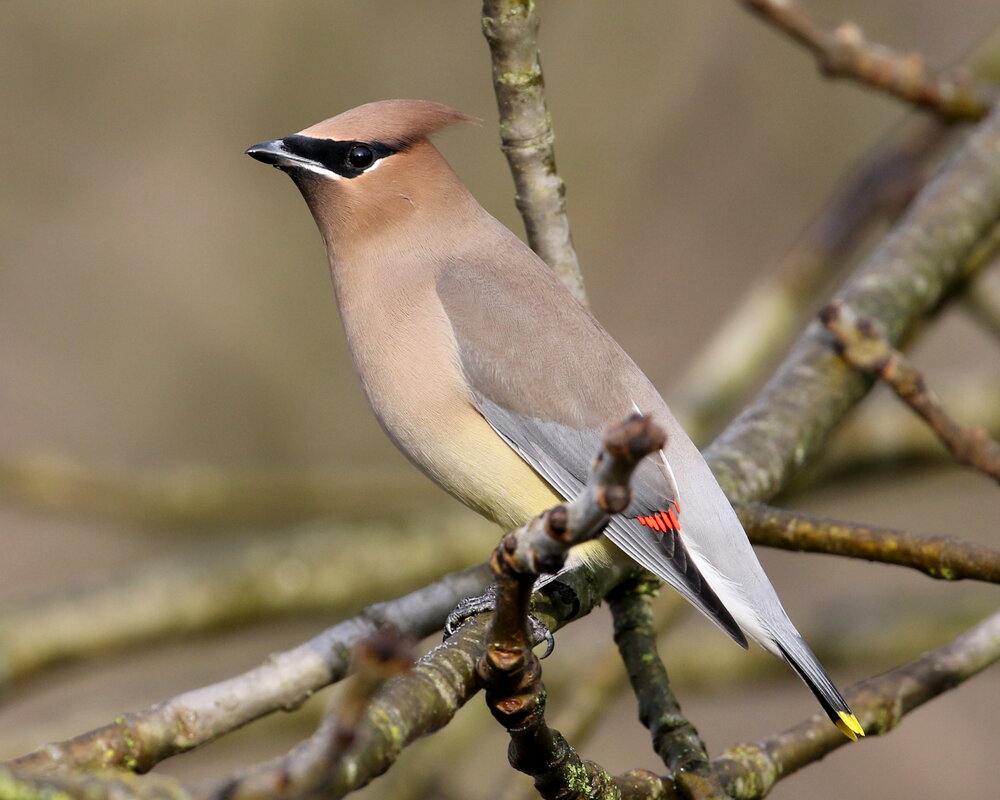
Cedar Waxwings are predominantly seen in North Dakota during the breeding season, although some individuals remain year-round. They are observed in 14% of summer checklists and 4% of winter checklists.
These elegant and social birds have pale brown heads, chests, and crests, which gradually fade to gray on their backs, wings, and tails. Their bellies boast a pale yellow hue, and their wings are adorned with bright yellow tips. Additionally, they exhibit a narrow black mask across their eyes and bright red wingtips.
Bombycilla cedrorum
Length: 5.5-6.7 in (14-17 cm)
Weight: 1.1 oz (32 g)
Wingspan: 8.7-11.8 in (22-30 cm)
Cedar Waxwings breed in Canada before migrating to the southern United States, Mexico, and Central America for the winter. However, some individuals remain year-round in the northern US states.
You can spot Cedar Waxwings in berry bushes, woodlands, grasslands, towns, and along streams. They primarily feed on fruit but also consume insects during the summer.
Listen to the captivating call of the Cedar Waxwing:
Credit: Peter Ward and Ken Hall, XC512254. Accessible at www.xeno-canto.org/512254.
Nests of Cedar Waxwings are constructed using twigs, grass, hair, and plant material, and they are lined with pine needles and soft grass. The female lays up to six eggs, which hatch in approximately twelve days. The young birds take about sixteen days to leave the nest.
To attract Cedar Waxwings to your backyard, plant native trees and shrubs that produce small fruits such as serviceberry, dogwood, juniper, winterberry, and hawthorn. You can also try offering fruit on platform feeders.
Fun Fact: Cedar Waxwings engage in a unique behavior of giving gifts when courting potential mates. They pass items between each other as part of their courtship rituals.
5. Yellow-headed Blackbird
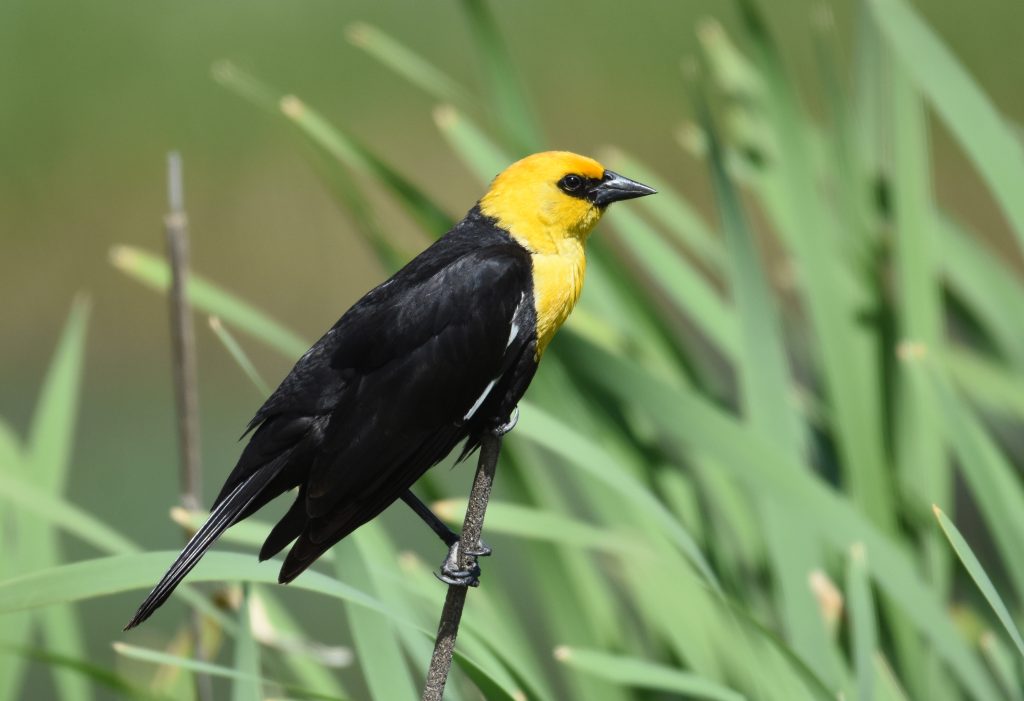
Yellow-headed Blackbirds spend their summers in North Dakota and can be observed from April to October. They appear in 23% of summer checklists.
These striking birds possess glossy black bodies, vibrant yellow heads and chests, and white patches on their wings in males. Females, on the other hand, have brown plumage instead of black, and their yellow heads are less vibrant. Yellow-headed Blackbirds are larger than Red-winged Blackbirds.
Xanthocephalus xanthocephalus
Length: 8.3-10.2 in (21-26 cm)
Weight: 1.6-3.5 oz (44-100 g)
Wingspan: 16.5-17.3 in (42-44 cm)
Yellow-headed Blackbirds breed in western and prairie wetlands, constructing their nests among the reeds. They forage over surrounding wetlands, grasslands, and fields, mainly feasting on insects during the summer.
After breeding, Yellow-headed Blackbirds migrate in large flocks to fields and farmlands in southwest states and Mexico for the winter.
Their diet consists of insects during the summer and transitions to seeds and grains during the winter.
Listen to the distinctive screeching buzz of Yellow-headed Blackbirds, accompanied by melodious notes:
Bobby Wilcox, XC544023. Accessible at www.xeno-canto.org/544023.
Nests of Yellow-headed Blackbirds are made from long, wet stems woven together and
attached to cattails or reeds above the water’s surface. The female lays 2 to 5 eggs, which take about two weeks to hatch, followed by another week or two before the young birds fledge.
Attract Yellow-headed Blackbirds to your yard with sunflower seeds.
Fun Fact: Yellow-headed Blackbirds exhibit a fascinating hunting behavior where they flip over stones to flush out insects.
6. Common Yellowthroat
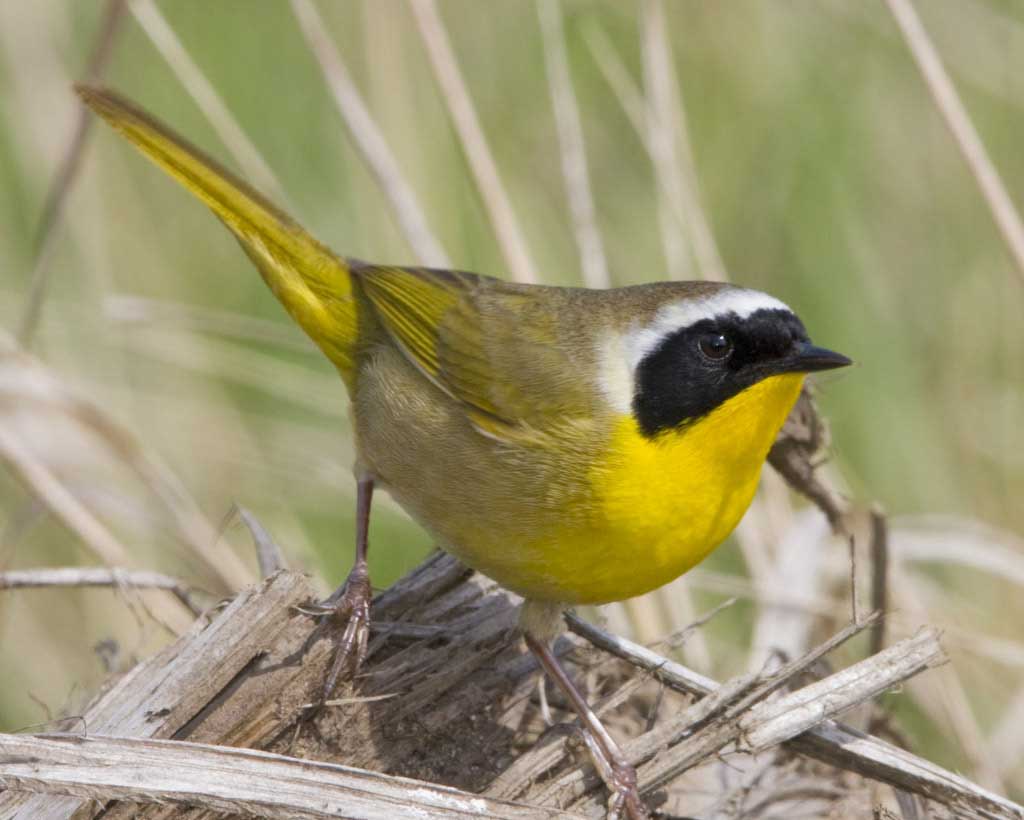
Common Yellowthroats are frequently seen in North Dakota during the breeding season, appearing in 22% of summer checklists. They are observed from mid-April until October.
These small songbirds have brownish backs and vibrant yellow undersides, with long tails. The males feature black masks across their faces. The brightness of their yellow plumage may vary geographically, and their undersides can exhibit more olive tones in some regions.
Geothlypis trichas
Length: 4.3-5.1 in (11-13 cm)
Weight: 0.3-0.3 oz (9-10 g)
Wingspan: 5.9-7.5 in (15-19 cm)
Common Yellowthroats spend the summer breeding across most of North America, excluding Alaska and northern Canada. Some individuals remain year-round along the Gulf Coast and in the Pacific Southwest. They migrate south for the winter.
These birds can often be found in marshy or wetland areas and brushy fields, residing within thick and tangled vegetation.
Listen to the enchanting song of the Common Yellowthroat:
Credit: Paul Marvin, XC629250. Accessible at www.xeno-canto.org/629250.
Nests of Common Yellowthroats are built by females near the ground in marshy areas, supported by reeds. The nest is crafted from grass, sedges, and supported by a platform of leaves and grass. They lay up to six eggs, which take around twelve days to hatch, and an additional ten days for the young birds to leave the nest.
To attract Common Yellowthroats to larger backyards, provide dense vegetation and native plants that attract insects.
Fun Fact: The presence of a black mask on Common Yellowthroats serves as a signal to male birds during courtship. They become aggressive towards fake birds with masks but show no aggression when the masks are absent.
7. Western Kingbird

Western Kingbirds are observed in North Dakota during the summer, from mid-April to September, appearing in 20% of checklists during this period.
These large flycatchers possess yellow bellies, whitish chests, gray heads, grayish-brown wings, and black tails with white edges.
Tyrannus verticalis
Length: 7.9-9.4 in (20-24 cm)
Weight: 1.3-1.6 oz (37-46 g)
Wingspan: 15.0-16.1 in (38-41 cm)
Western Kingbirds breed during the summer in western US states, the plains area, and into Canada. They migrate to Mexico and Central America for the winter, although some individuals may overwinter in southern Florida.
You can often spot Western Kingbirds in open habitats, frequently perched on fences and utility lines, patiently waiting for insects to fly by before catching them in mid-flight.
Listen to the distinctive call of the Western Kingbird:
Credit: Paul Marvin, XC552239. Accessible at www.xeno-canto.org/552239.
Nests of Western Kingbirds are typically built in trees or shrubs, but they may also nest in human-made structures or posts. The female constructs the nest using twigs, grass, and plant material, creating a woven cup.
They lay up to seven eggs, which take two to nearly three
weeks to hatch. The young birds spend a similar duration before leaving the nest.
To attract Western Kingbirds to your yard, create an insect-friendly environment and plant elderberry or hawthorn trees, which they will also visit for fruit.
Fun Fact: Western Kingbird parents continue to feed their young for about three weeks after they leave the nest.
8. Yellow-rumped Warbler

Yellow-rumped Warblers can be observed in North Dakota during migration, from April to May and mid-August to October. They are reported in up to 48% of checklists during migration.
These warblers display gray plumage with flashes of yellow on their face, sides, and rump, as well as white in their wings.
Females may exhibit slight brownish tones, while winter birds appear paler brown with bright yellow rumps and sides, transitioning back to yellow and gray in spring.
Setophaga coronata
Length: 4.7-5.5 in (12-14 cm)
Weight: 0.4-0.5 oz (12-13 g)
Wingspan: 7.5-9.1 in (19-23 cm)
Yellow-rumped Warblers predominantly breed in Canada, parts of the Rockies, and the Appalachian mountains.
During migration, they can be seen in the Midwest before wintering in southern and southwestern US states, the Pacific Coast, Mexico, and Central America.
You can find Yellow-rumped Warblers in coniferous forests, particularly during the breeding season. In winter, they can be spotted in open areas with fruiting shrubs. Their diet consists mostly of insects during the summer, shifting to predominantly fruit, including bayberry and wax myrtle, during migration and winter.
Listen to the captivating song of the Yellow-rumped Warbler:
Credit: Christopher McPherson, XC602699. Accessible at www.xeno-canto.org/602699.
Nests of Yellow-rumped Warblers are constructed by females in conifer trees using twigs, pine needles, and grass. The nest is lined with soft grass, moss, and hair. They lay up to six eggs, which take around two weeks to hatch, followed by two more weeks before the young birds leave the nest.
To attract Yellow-rumped Warblers to your backyard, offer sunflower seeds, suet, raisins, and peanut butter.
Fun Fact: Yellow-rumped Warblers form flocks numbering in the thousands during winter and can be quite territorial when it comes to other species approaching their feeding grounds.
9. Baltimore Oriole (Female)
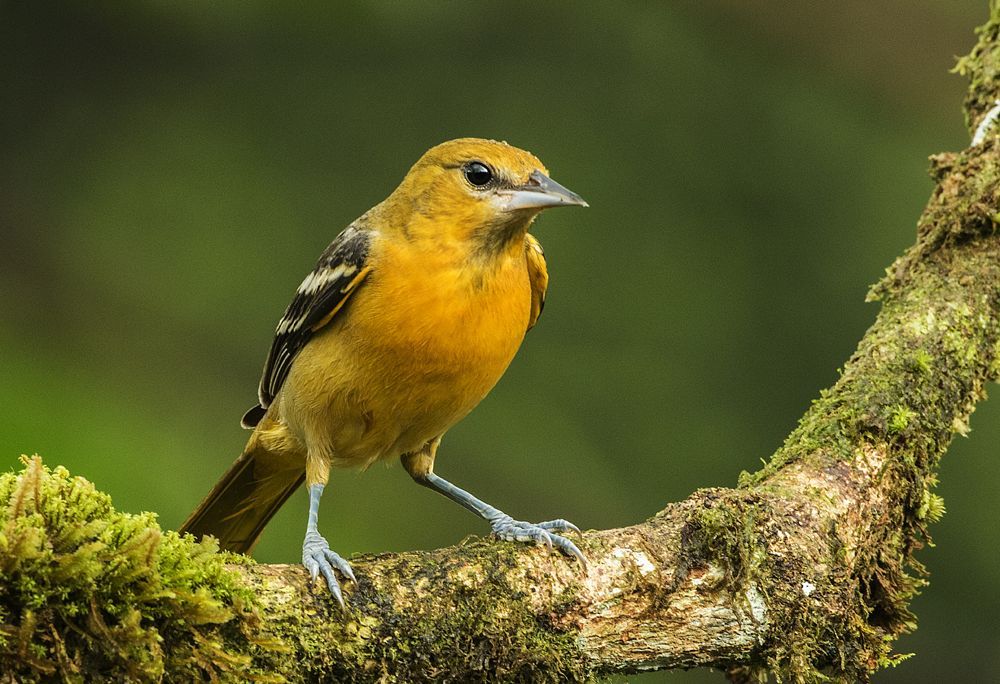
Baltimore Orioles spend their summers in North Dakota, primarily from May to September, and are found in 12% of checklists during this period.
These birds are colorful indicators of spring in the eastern part of North America. Adult males exhibit bright orange and black plumage with white wing bars.
Females display yellowish undersides and heads, along with grayish-brown wings. Their backs have a brownish-yellow tone. Baltimore Orioles are roughly the same size as Robins but possess a more slender physique. They belong to the blackbird family.
Icterus galbula
Length: 6.7-7.5 in (17-19 cm)
Weight: 1.1-1.4 oz (30-40 g)
Wingspan: 9.1-11.8 in (23-30 cm)
Baltimore Orioles breed in eastern and central US states, as well as central-southern Canadian provinces, along the southern US border.
During winter, Baltimore Orioles migrate to Florida, Central America, and the Caribbean, with some departing as early as July.
You can often find Baltimore Orioles in open woodlands, along riverbanks, and at forest edges, where
they forage for insects and feast on various fruits. They are frequent visitors to parks and backyards.
Their diet consists of insects such as beetles, crickets, grasshoppers, spiders, and snails. Baltimore Orioles also play a role in controlling pest species. They have a diverse taste for fruits but may cause damage to crops like raspberries, mulberries, cherries, bananas, and oranges.
Listen to the melodious flute-like song of the Baltimore Oriole:
Credit: Christopher McPherson, XC690956. Accessible at www.xeno-canto.org/690956.
To attract Baltimore Orioles to your backyard, offer halved oranges on a platform feeder or hang them from trees. Oriole feeders filled with sugar water can also entice them. Planting fruiting and nectar-producing plants like raspberries, crab apples, and trumpet vines will further attract them.
Fun Fact: Baltimore Orioles construct incredible hanging bag-like nests woven from various fibers.
10. American Redstart (Female)
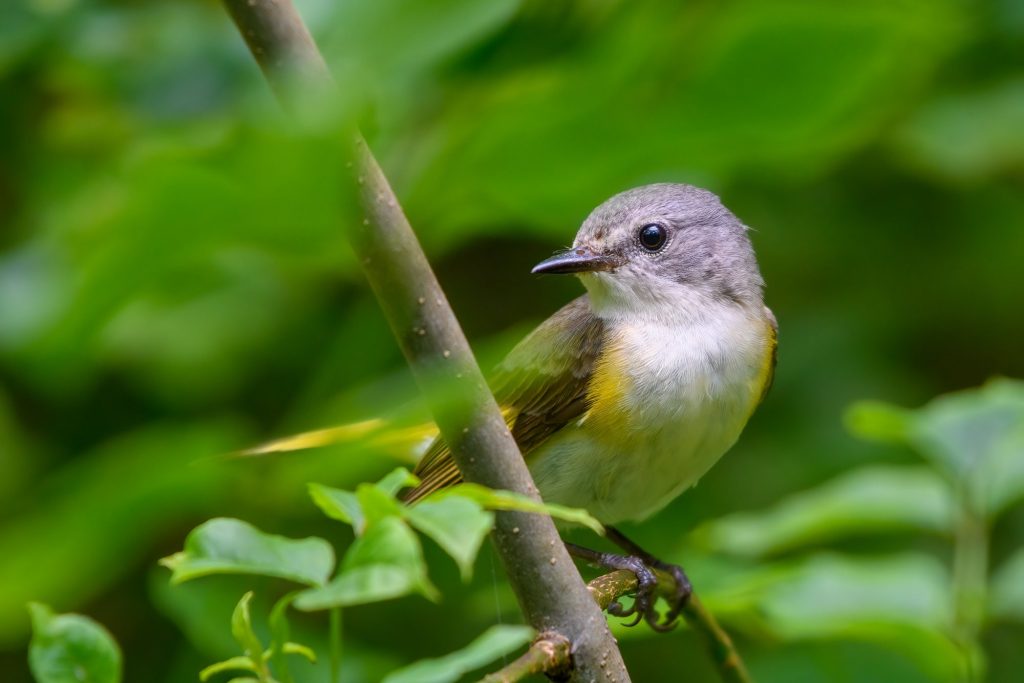
Female American Redstarts can be spotted in North Dakota from May to mid-October, appearing in 9% of summer checklists.
Male American Redstarts exhibit mostly black plumage with bright orange patches and a white belly. Females, however, have olive-gray plumage instead of black, adorned with numerous yellow patches.
Setophaga ruticilla
Length: 4.3-5.1 in (11-13 cm)
Weight: 0.2-0.3 oz (6-9 g)
Wingspan: 6.3-7.5 in (16-19 cm)
American Redstarts breed in eastern US states and Canada, extending into northwestern US states. They may also be observed during migration in central and western US states.
These birds can be found in deciduous woodlands, where they feed on insects. They are also known to visit backyards and thickets to consume berries such as serviceberry and magnolia.
Listen to the enchanting song of the American Redstart:
Credit: Nick Kiehl, XC522368. Accessible at www.xeno-canto.org/522368.
Nests of American Redstarts are typically situated close to tree trunks in trees or large shrubs. The nest is constructed by the female using bark, grass, and other plant materials, forming a cozy cup. They lay up to five eggs, which hatch in just under two weeks, with the young birds leaving the nest within a week or two.
To attract American Redstarts to your backyard, provide berry plants such as magnolia and serviceberry.
Fun Fact: American Redstart parents selectively feed certain chicks, rather than feeding all of them indiscriminately.
11. Orchard Oriole
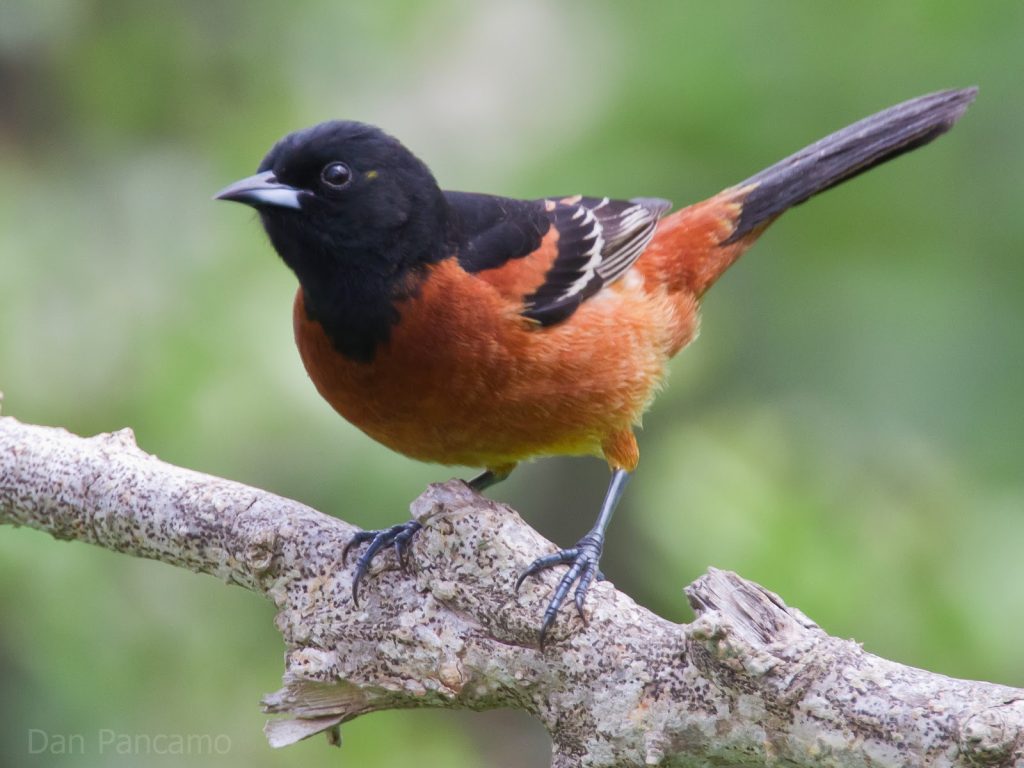
Orchard Orioles can be observed in North Dakota during the summer breeding season, typically from May to September. They are present in approximately 7% of summer checklists.
These orioles exhibit sexual dimorphism, with the males displaying a striking combination of bright chestnut-orange plumage on their underparts and a deep black color on their heads, wings, and tails. Females, on the other hand, have a more subdued appearance, featuring olive-green upperparts and yellowish underparts.
Icterus spurius
Length: 6.3-7.5 in (16-19 cm)
Weight: 0.6-0.8 oz (17-22 g)
Wingspan: 9.1-10.6 in (23-27 cm)
Orchard Orioles breed in eastern and central US states, as well as southern Canadian provinces. They migrate to Mexico, Central America, and the Caribbean for the winter.
These orioles can be found in orchards, woodlands, and open areas with scattered trees. They primarily feed on insects during the breeding season, but also consume nectar, fruits, and berries.
Listen to the pleasant song of the Orchard Oriole:
Credit: Benjamin Clock, XC571439. Accessible at www.xeno-canto.org/571439.
Nests of Orchard Orioles are woven from various plant fibers, suspended from the branches of deciduous trees, typically at the end of a drooping branch. They lay 3 to 5 eggs, which hatch after about two weeks. The young birds leave the nest approximately two weeks later.
To attract Orchard Orioles to your backyard, provide fruit feeders with oranges and nectar feeders with sugar water. Planting fruit-bearing trees and shrubs will also help attract them.
Fun Fact: Orchard Orioles have been observed engaging in polygyny, where a male mates with multiple females and cares for the nests of his offspring.
12. Yellow-throated Vireo
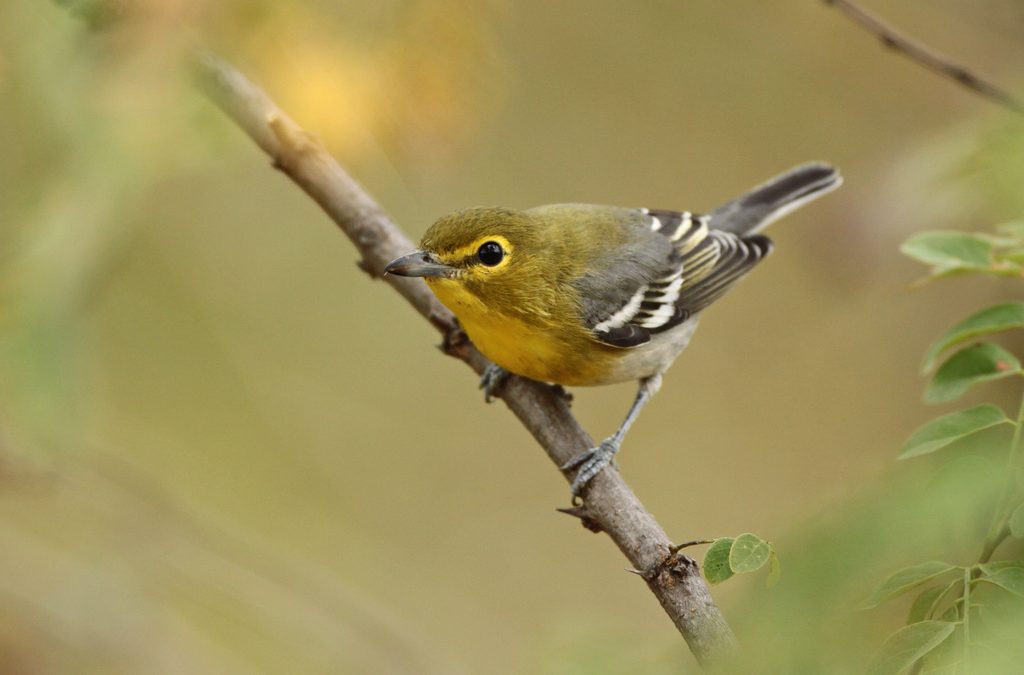
Yellow-throated Vireos are occasionally spotted in North Dakota during the breeding season, typically from May to September. They appear in a small percentage of summer checklists.
These vireos possess a distinct yellow throat, as their name suggests. They have olive-green upperparts, whitish underparts, and a black stripe running through their eyes.
Vireo flavifrons
Length: 4.7-5.5 in (12-14 cm)
Weight: 0.3-0.4 oz (9-11 g)
Wingspan: 8.3-9.4 in (21-24 cm)
Yellow-throated Vireos breed across eastern and central US states, as well as southern Canadian provinces. They migrate to Mexico, Central America, and the Caribbean for the winter.
These vireos inhabit deciduous forests and can often be found foraging in the middle and upper canopy. They primarily feed on insects, including caterpillars, beetles, and other arthropods.
Listen to the melodic song of the Yellow-throated Vireo:
Credit: Jay McGowan, XC675216. Accessible at www.xeno-canto.org/675216.
Nests of Yellow-throated Vireos are built by the female, typically suspended from a forked branch in the outer foliage of a tree. The nest is constructed using twigs, grass, bark, and spider silk. They lay 3 to 5 eggs, which hatch after about two weeks. The young birds fledge approximately two weeks later.
Attracting Yellow-throated Vireos to your backyard can be challenging, but providing a diverse habitat with mature trees and shrubs may increase the chances of attracting them.
Fun Fact: Yellow-throated Vireos are known for their complex songs, consisting of a series of varied phrases and musical notes.
13. Dickcissel
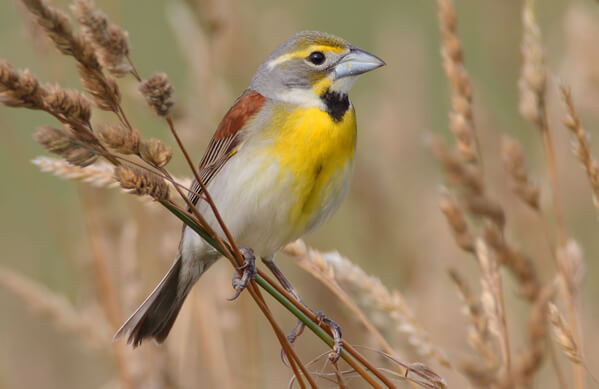
Dickcissels can be observed in North Dakota during the summer breeding season, typically from May to September. They are present in a small percentage of summer checklists.
These small songbirds feature a unique color pattern, with males displaying a bright yellow breast, grayish upperparts, and a distinct black patch on their throat. Females, on the other hand, have a more subdued appearance, with pale yellowish underparts and brownish upperparts.
Spiza americana
Length: 5.5-6.3 in (14-16 cm)
Weight: 0.7-0.8 oz (20-22 g)
Wingspan: 9.1-9.8 in (23-25 cm)
Dickcissels breed across the central and eastern parts of the US, as well as southern Canadian provinces. They migrate to southern Mexico and Central America for the winter.
These birds can be found in grasslands, prairies, and open areas with scattered trees. They primarily feed on insects during the breeding season but also consume seeds, grains, and small fruits.
Listen to the distinctive song of the Dickcissel:
Credit: Andrew Spencer, XC557631. Accessible at www.xeno-canto.org/557631.
Nests of Dickcissels are built by the female on the ground, typically concealed among dense vegetation. The nest is constructed using grass, stems, and leaves, forming a cup-shaped structure. They lay 3 to 5 eggs, which hatch after about two weeks. The young birds fledge approximately two weeks later.
Attracting Dickcissels to your backyard can be challenging, as they primarily inhabit open grasslands. Providing tall grasses and native prairie plants may increase the chances of attracting them.
Fun Fact: The name “Dickcissel” comes from the distinctive song of the male, which sounds like “dick-dick-ciss-ciss-ciss.”
14. Scarlet Tanager
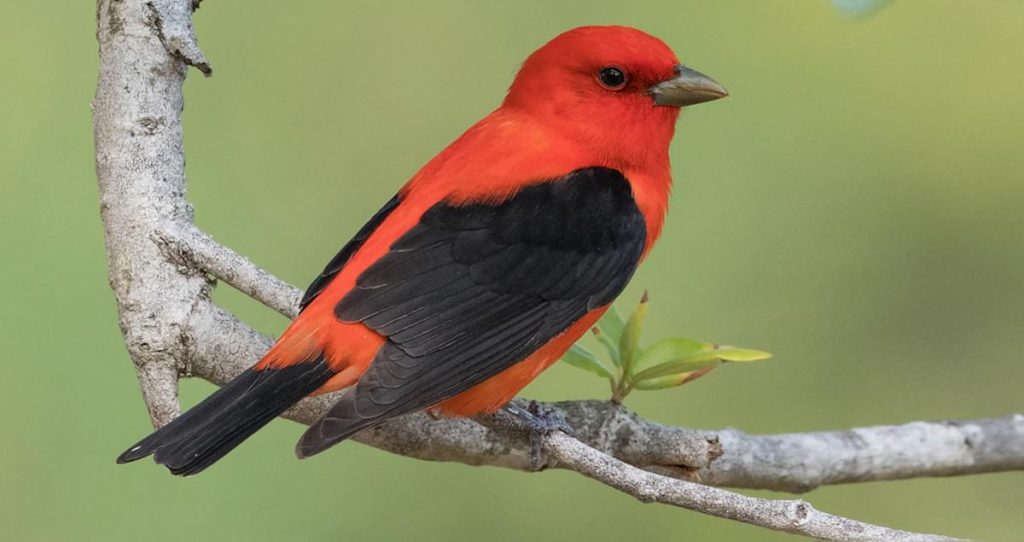
Scarlet Tanagers can occasionally be spotted in North Dakota during the summer breeding season, typically from May to September. They appear in a small percentage of summer checklists.
These tanagers are known for their vibrant plumage, with adult males displaying a striking scarlet-red coloration, contrasting with their black wings and tail. Females, however, have a more subdued appearance, featuring yellow-greenish plumage.
Piranga olivacea
Length: 6.3-7.1 in (16-18 cm)
Weight: 0.8-1.2 oz (23-34 g)
Wingspan: 9.8-10.6 in (25-27 cm)
Scarlet Tanagers breed across eastern and central US states, as well as southern Canadian provinces. They migrate to northern South America for the winter.
These tanagers inhabit deciduous forests, where they forage for insects, spiders, and fruits. They are often found in the middle and upper canopy of trees.
Listen to the melodious song of the Scarlet Tanager:
Credit: Jesse Fagan, XC697169. Accessible at www.xeno-canto.org/697169.
Nests of Scarlet Tanagers are built by the female, usually on horizontal branches of deciduous trees, at a considerable height from the ground. The nest is constructed using twigs, grass, and leaves, forming a cup-shaped structure. They lay 3 to 5 eggs, which hatch after about two weeks. The young birds fledge approximately two weeks later.
Attracting Scarlet Tanagers to your backyard can be challenging, as they primarily inhabit forested areas. However, providing a diverse habitat with mature trees and offering fruits, such as oranges or grape jelly, may increase the chances of attracting them.
Fun Fact: Scarlet Tanagers undergo a complete molt after breeding, transforming their vibrant scarlet plumage into a more greenish hue similar to that of the females.
15. Evening Grosbeak
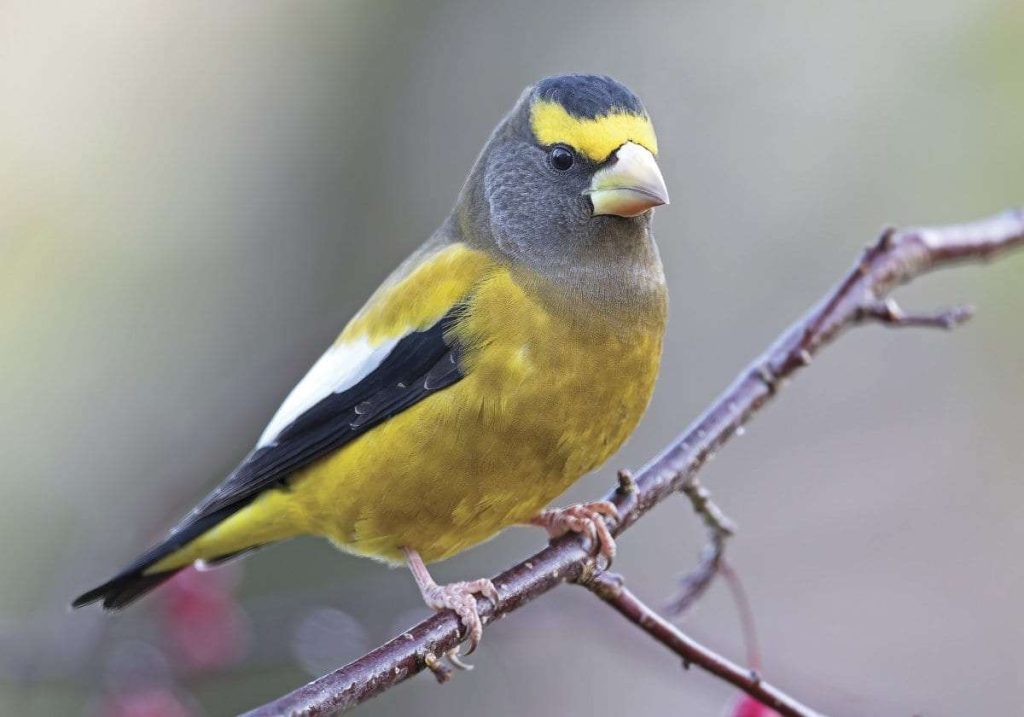
Evening Grosbeaks can occasionally be observed in North Dakota during the winter season, typically from November to March. They appear in a small percentage of winter checklists.
These robust finches display a distinctive color pattern, with males featuring bright yellow plumage on their head, back, and underparts. They have a large beak, which gives them their name. Females, on the other hand, have a more muted appearance, with olive-green upperparts and yellowish underparts.
Coccothraustes vespertinus
Length: 6.7-7.5 in (17-19 cm)
Weight: 1.7-2.3 oz (49-65 g)
Wingspan: 11.8-14.2 in (30-36 cm)
Evening Grosbeaks breed across coniferous forests in western North America. During winter, they can exhibit irruptive behavior, moving in large flocks to search for food. They may also migrate southward, including to North Dakota.
These grosbeaks primarily feed on seeds, including those from various conifer species, as well as buds, fruits, and insects.
Listen to the unique call of the Evening Grosbeak:
Credit: Andrew Spencer, XC417525. Accessible at www.xeno-canto.org/417525.
Nests of Evening Grosbeaks are built by the female, typically located in coniferous trees. The nest is constructed using twigs, roots, and bark, forming a sturdy cup-shaped structure. They lay 2 to 5 eggs, which hatch after about two weeks. The young birds fledge approximately two weeks later.
Attracting Evening Grosbeaks to your backyard during winter can be challenging, as they
have irregular migration patterns. However, providing a variety of seeds, such as sunflower seeds, and offering a reliable source of water may increase the chances of attracting them.
Fun Fact: Evening Grosbeaks have a unique call described as a melodious “queedle-queedle” or “eek-eek,” which can be heard from a distance.
16. Yellow-rumped Warbler
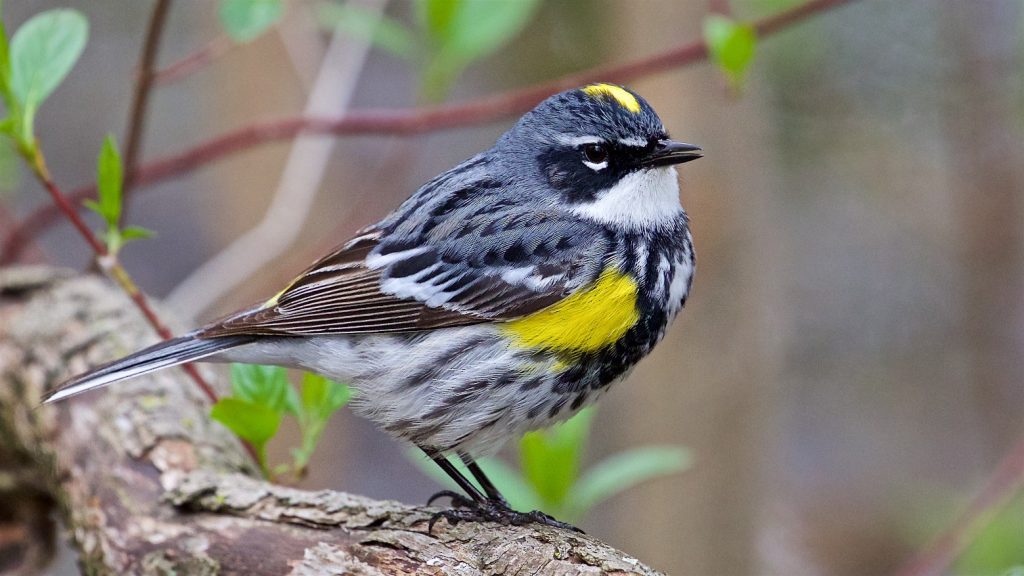
Yellow-rumped Warblers can be spotted in North Dakota during migration, typically from April to May and from mid-August to October. They are recorded in a significant percentage of checklists during migration.
These warblers display a distinct color pattern, with males showcasing a combination of grayish-blue upperparts, a yellow throat and chest, and white patches on the wings. Females and nonbreeding individuals have more subdued plumage, with brownish-gray upperparts and a pale yellow throat.
Setophaga coronata
Length: 4.7-5.5 in (12-14 cm)
Weight: 0.4-0.5 oz (12-14 g)
Wingspan: 7.5-9.1 in (19-23 cm)
Yellow-rumped Warblers breed primarily in Canada, as well as parts of the Rockies and the Appalachian Mountains. During migration, they can be seen in the Midwest. In winter, they migrate to open areas with fruiting shrubs, including North Dakota.
These warblers are commonly found in coniferous forests, particularly during the breeding season. They feed on a variety of insects, such as caterpillars, beetles, and spiders, during summer. In winter, their diet shifts to include more fruit, including bayberry and wax myrtle.
Listen to the sweet song of the Yellow-rumped Warbler:
Credit: Christopher McPherson, XC602699. Accessible at www.xeno-canto.org/602699.
Nests of Yellow-rumped Warblers are constructed by females in conifer trees using twigs, pine needles, and grass, lined with soft grass, moss, and hair. They lay up to six eggs, which take around two weeks to hatch. The young birds remain in the nest for another two weeks before fledging.
To attract Yellow-rumped Warblers to your backyard, offer sunflower seeds, suet, raisins, and peanut butter. Creating a habitat with diverse fruiting plants can also provide additional food sources.
Fun Fact: Yellow-rumped Warblers form large flocks numbering in the thousands during winter, and they can be quite aggressive towards other species when competing for food.
17. Orange-crowned Warbler
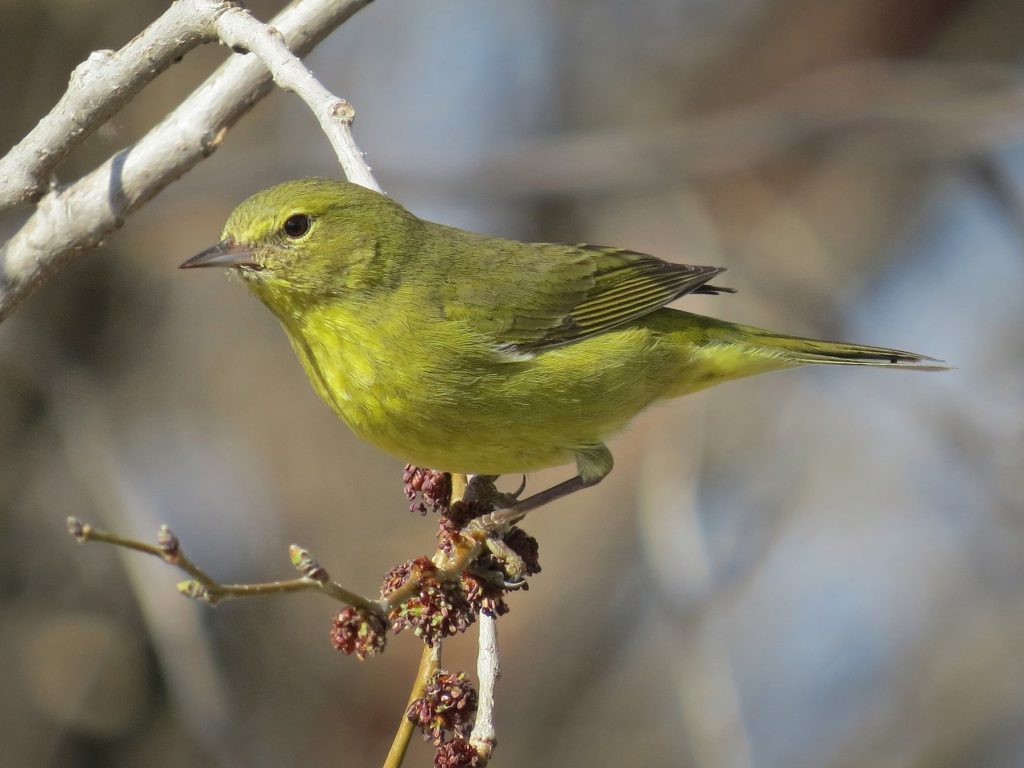
Orange-crowned Warblers can occasionally be spotted in North Dakota during migration, typically from April to May and from mid-August to October. They appear in a small percentage of checklists during migration.
These warblers have a rather plain appearance, with olive-green upperparts and pale yellow underparts. Their name comes from a subtle orange patch on the crown, which is often difficult to see.
Leiothlypis celata
Length: 4.7-5.1 in (12-13 cm)
Weight: 0.3-0.4 oz (9-11 g)
Wingspan: 6.7-7.5 in (17-19 cm)
Orange-crowned Warblers breed across western North America, including parts of Canada and the US. During migration, they can be observed in various regions, including North Dakota.
These warblers inhabit a range of habitats, including open woodlands, shrubby areas, and gardens. They primarily feed on insects, including beetles, caterpillars, and spiders, as well as small fruits and nectar.
Listen to the subtle song of the Orange-crowned Warbler:
Credit: Ted Floyd, XC309231. Accessible at www.xeno-canto.org/309231.
Nests of Orange-crowned Warblers are built by females, often hidden in dense vegetation close to the ground. The nest is constructed using twigs, grass, and moss, forming a cup-shaped structure. They lay 4 to 6 eggs, which hatch after about two weeks. The young birds fledge approximately two weeks later.
Attracting Orange-crowned Warblers to your backyard can be challenging, as they have diverse habitat preferences. However, providing dense shrubs, trees with berries, and insect-attracting plants may increase the chances of attracting them.
Fun Fact: Orange-crowned Warblers are known for their secretive behavior, often remaining hidden in foliage and rarely singing their song in the open.
18. Palm Warbler
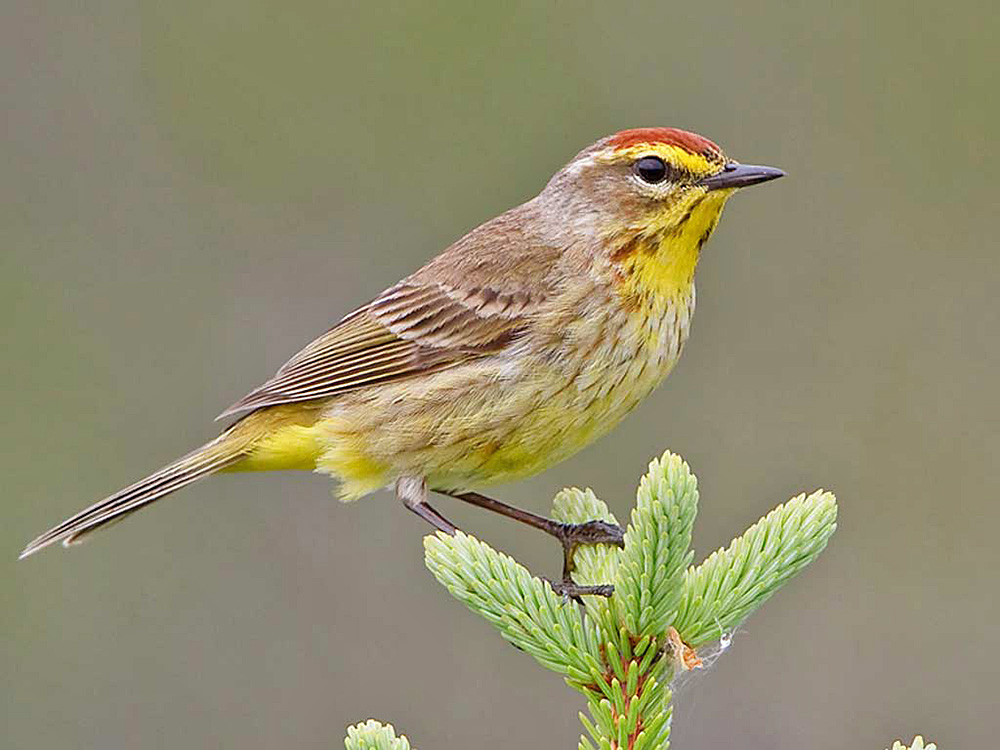
Palm Warblers can be observed in North Dakota during migration, typically from April to May and from mid-August to October. They are recorded in a significant percentage of checklists during migration.
These warblers have a distinctive appearance, with a combination of brownish upperparts, a yellow throat and underparts, and a pale eyebrow stripe. They often wag their tails, a behavior that helps in identifying them.
Setophaga palmarum
Length: 4.7-5.5 in (12-14 cm)
Weight: 0.4-0.5 oz (12-14 g)
Wingspan: 7.9-8.3 in (20-21 cm)
Palm Warblers breed in the far north, particularly in the boreal forests of Canada. During migration, they can be seen in various regions, including North Dakota.
These warblers are commonly found in open habitats, such as weedy fields, scrublands, and forest edges. They primarily feed on insects, including beetles, flies, and caterpillars, often foraging on the ground.
Listen to the distinctive song of the Palm Warbler:
Credit: Richard E. Webster, XC662551. Accessible at www.xeno-canto.org/662551.
Nests of Palm Warblers are typically built on or near the ground in open areas, such as grassy fields or wetlands. The nest is constructed using grasses, twigs, and moss, forming an open cup-shaped structure. They lay 4 to 5 eggs, which hatch after about two weeks. The young birds fledge approximately two weeks later.
Attracting Palm Warblers to your backyard can be challenging, as they are primarily a migratory species. However, providing a diverse habitat with open areas and insect-attracting plants may increase the chances of spotting them during migration.
Fun Fact: Palm Warblers are one of the few warbler species known to wag their tails frequently, which can be a helpful identification feature.
19. Magnolia Warbler

Magnolia Warblers can occasionally be spotted in North Dakota during migration, typically from April to May and from mid-August to October. They appear in a small percentage of checklists during migration.
These warblers exhibit a striking plumage, with black upperparts adorned with bold white stripes and a bright yellow throat and underparts. They also have a white eyering and a black mask across the eyes.
Setophaga magnolia
Length: 4.7-5.1 in (12-13 cm)
Weight: 0.3-0.4 oz (9-11 g)
Wingspan: 7.5-8.3 in (19-21 cm)
Magnolia Warblers breed primarily in the boreal forests of Canada and parts of the northeastern US. During migration, they can be observed in various regions, including North Dakota.
These warblers inhabit a range of forested habitats, including coniferous and mixed forests. They primarily feed on insects, such as caterpillars, flies, and beetles, often foraging in the middle and upper canopy.
Listen to the melodious song of the Magnolia Warbler:
Credit: Andrew Spencer, XC329512. Accessible at www.xeno-c
anto.org/329512.
Nests of Magnolia Warblers are built by females, often hidden within dense vegetation close to the ground. The nest is constructed using twigs, grass, and plant fibers, forming a cup-shaped structure. They lay 4 to 5 eggs, which hatch after about two weeks. The young birds fledge approximately two weeks later.
Attracting Magnolia Warblers to your backyard can be challenging, as they primarily breed in boreal forests. However, providing a diverse habitat with trees, shrubs, and a source of insects may attract them during migration.
Fun Fact: Despite their name, Magnolia Warblers do not have a strong association with magnolia trees. The name was given based on the mistaken belief that they primarily fed on magnolia flower buds.
20. Wilson’s Warbler

Wilson’s Warblers can be observed in North Dakota during migration, typically from April to May and from mid-August to October. They are recorded in a significant percentage of checklists during migration.
These warblers have a distinct appearance, with bright yellow plumage, olive-green upperparts, and a black cap on the head. Males have a more prominent cap, while females have a slightly duller appearance.
Cardellina pusilla
Length: 4.3-4.7 in (11-12 cm)
Weight: 0.3-0.4 oz (8-11 g)
Wingspan: 6.7-7.5 in (17-19 cm)
Wilson’s Warblers breed primarily in western North America, including parts of Canada and the US. During migration, they can be seen in various regions, including North Dakota.
These warblers favor habitats such as moist thickets, shrubby areas, and willow-lined streams. They primarily feed on insects, including small caterpillars, flies, and spiders.
Listen to the energetic song of the Wilson’s Warbler:
Credit: Gregory Budney, XC484857. Accessible at www.xeno-canto.org/484857.
Nests of Wilson’s Warblers are built by females close to the ground, typically in dense shrubs or vegetation. The nest is constructed using grass, moss, and plant fibers, forming a cup-shaped structure. They lay 4 to 6 eggs, which hatch after about two weeks. The young birds fledge approximately two weeks later.
Attracting Wilson’s Warblers to your backyard can be challenging, as they are primarily migratory. However, providing dense shrubs, a source of insects, and a small water feature may increase the chances of attracting them during migration.
Fun Fact: Wilson’s Warblers have a distinctive tail-wagging behavior, constantly flicking their tail up and down while foraging or singing.
21. Nashville Warbler
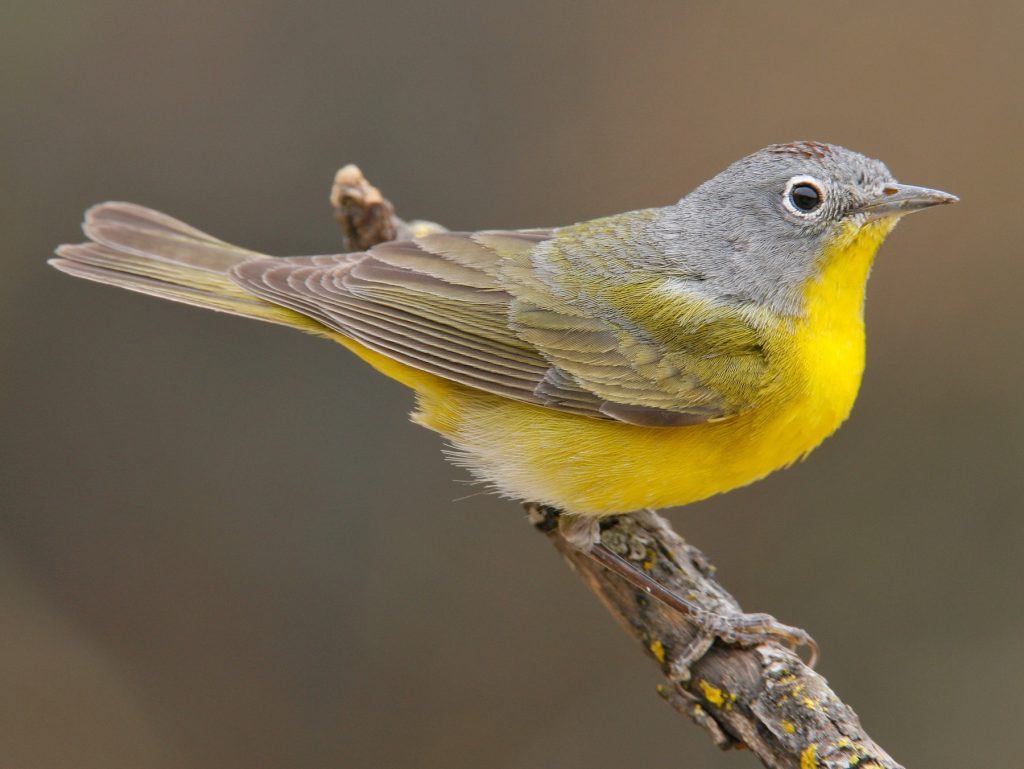
Nashville Warblers can occasionally be spotted in North Dakota during migration, typically from April to May and from mid-August to October. They appear in a small percentage of checklists during migration.
These warblers have a rather plain appearance, with olive-green upperparts, a yellow throat and underparts, and a grayish head. They also have a distinct white eyering.
Leiothlypis ruficapilla
Length: 4.3-4.7 in (11-12 cm)
Weight: 0.3-0.4 oz (8-11 g)
Wingspan: 6.7-7.5 in (17-19 cm)
Nashville Warblers breed primarily in the boreal forests of Canada and parts of the northeastern US. During migration, they can be observed in various regions, including North Dakota.
These warblers inhabit a range of forested habitats, including deciduous and mixed forests. They primarily feed on
insects, such as small caterpillars, flies, and beetles, often foraging in the middle and upper canopy.
Listen to the sweet song of the Nashville Warbler:
Credit: Andrew Spencer, XC328979. Accessible at www.xeno-canto.org/328979.
Nests of Nashville Warblers are built by females, typically close to the ground in shrubs or vegetation. The nest is constructed using grass, plant fibers, and fine twigs, forming a cup-shaped structure. They lay 4 to 6 eggs, which hatch after about two weeks. The young birds fledge approximately two weeks later.
Attracting Nashville Warblers to your backyard can be challenging, as they primarily breed in boreal forests. However, providing a diverse habitat with trees, shrubs, and a source of insects may attract them during migration.
Fun Fact: The Nashville Warbler is named after the city of Nashville, Tennessee, where the species was first identified by renowned naturalist Alexander Wilson.
22. Canada Warbler
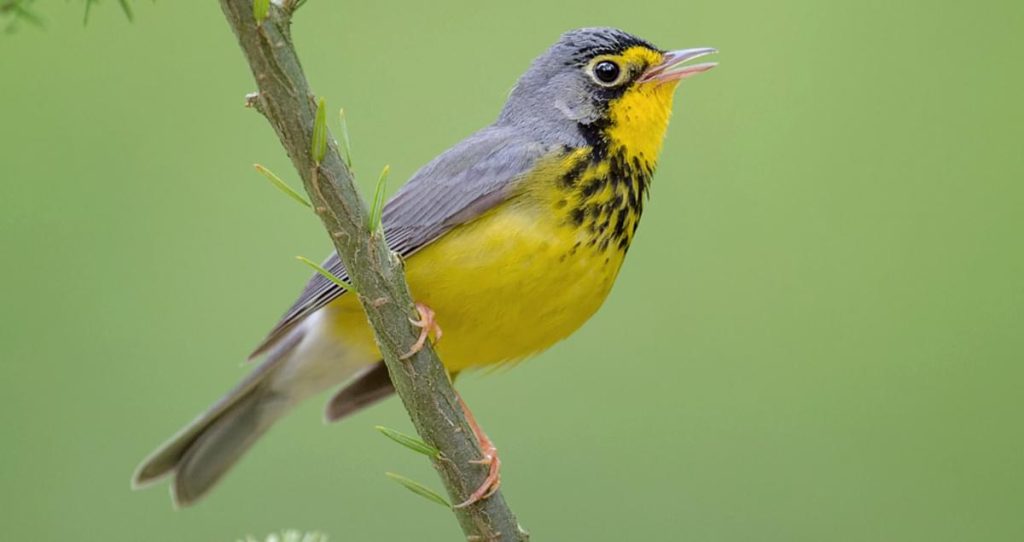
Canada Warblers can be observed in North Dakota during migration, typically from April to May and from mid-August to October. They are recorded in a significant percentage of checklists during migration.
These warblers have a unique appearance, with grayish-blue upperparts, bright yellow underparts, and a distinctive necklace-like pattern of black streaks across the chest. Males and females have similar plumage.
Cardellina canadensis
Length: 4.7-5.1 in (12-13 cm)
Weight: 0.3-0.4 oz (9-11 g)
Wingspan: 7.5-8.3 in (19-21 cm)
Canada Warblers breed primarily in the boreal forests of Canada and parts of the northeastern US. During migration, they can be seen in various regions, including North Dakota.
These warblers favor habitats such as moist forests, particularly those with dense understory vegetation. They primarily feed on insects, including small caterpillars, flies, and spiders.
Listen to the beautiful song of the Canada Warbler:
Credit: Jonathan Jongsma, XC576984. Accessible at www.xeno-canto.org/576984.
Nests of Canada Warblers are built by females close to the ground, typically in dense shrubs or vegetation. The nest is constructed using grass, moss, and plant fibers, forming a cup-shaped structure. They lay 4 to 6 eggs, which hatch after about two weeks. The young birds fledge approximately two weeks later.
Attracting Canada Warblers to your backyard can be challenging, as they primarily breed in boreal forests. However, providing a diverse habitat with trees, shrubs, and a source of insects may attract them during migration.
Fun Fact: Canada Warblers have a unique feeding behavior known as “gleaning.” They search for insects by hopping along branches and foliage, plucking prey items from the surfaces.
23. Cape May Warbler

Cape May Warblers can occasionally be spotted in North Dakota during migration, typically from April to May and from mid-August to October. They appear in a small percentage of checklists during migration.
These warblers have a striking appearance, with a mix of vibrant colors. They have yellowish-green upperparts with bold black streaks, a yellow throat and underparts, and a distinctive chestnut cheek patch. Males and females have similar plumage, although females may appear slightly duller.
Setophaga tigrina
Length: 4.7-5.1 in (12-13 cm)
Weight: 0.3-0.4 oz (9-11 g)
Wingspan: 7.5-8.7 in (19-22 cm)
Cape May Warblers breed primarily in the boreal forests of Canada, particularly in spruce and fir trees. During migration, they can be observed in various regions, including North Dakota.
These warblers prefer habitats with coniferous trees and also visit flowering trees and shrubs for nectar. They primarily feed on insects, including spruce budworms, caterpillars, and other small arthropods.
Listen to the unique song of the Cape May Warbler:
Credit: Daniel Parker, XC659445. Accessible at www.xeno-canto.org/659445.
Nests of Cape May Warblers are built by females in the lower branches of conifer trees, typically using twigs, grasses, and plant fibers. The nest is cup-shaped and lined with finer materials. They lay 3 to 7 eggs, which hatch after about two weeks. The young birds fledge approximately two weeks later.
Attracting Cape May Warblers to your backyard can be challenging, as they primarily breed in boreal forests. However, providing a diverse habitat with coniferous trees and flowering plants may increase the chances of attracting them during migration.
Fun Fact: Despite its name, the Cape May Warbler has no significant association with Cape May, New Jersey. The species was first discovered there during migration in the early 19th century.
So there you have it! A comprehensive list of 23 yellow birds you may spot in North Dakota during different seasons and migration periods. Enjoy birdwatching and exploring the fascinating world of these vibrant feathered creatures!
